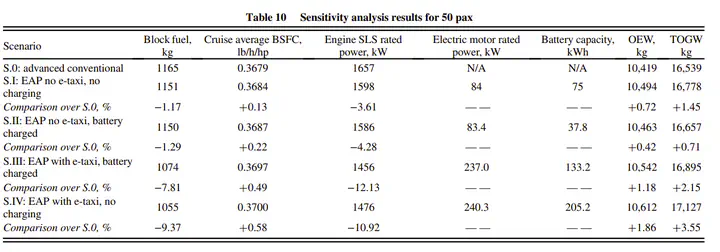System Analysis and Design Space Exploration of Regional Aircraft with Electrified Powertrains
 Results of the sensitivity analysis of the 50 passenger hybrid electric aircraft.
Results of the sensitivity analysis of the 50 passenger hybrid electric aircraft.Abstract
This paper explores the design spaces of a thin-haul and a regional aircraft with parallel hybrid-electric propulsion architectures for a 2030 entry into service date. Notional technology reference aircraft models were developed for a 19- and a 50-passenger aircraft based on publicly available data on Beechcraft 1900D and ATR 42-600, respectively. A set of airframe and propulsion system technologies projected to reach maturity by 2030 was infused into the aircraft models. Parametric, physics-based models were created for the charge-depleting hybrid architecture. Different modes of operation were identified and parameterized with a range of design variables to investigate the feasibility and trade space for peak power shaving, climb power boosting, electric taxi, battery usage schedules, and in-flight battery recharge strategies. Thousands of electrified aircraft concepts with varying electrification, operation, and technology scenarios were sized under the same system-level requirements as their conventional counterpart. The resulting multidisciplinary design space exploration environment was used to identify the optimum vision system designs and modes of operation for the minimum block fuel-burn objective. It has been found that both vehicle classes with the charge-depleting parallel hybrid electric architecture provided fuel-burn benefits over their 2030 advanced technology counterparts under certain operational modes.